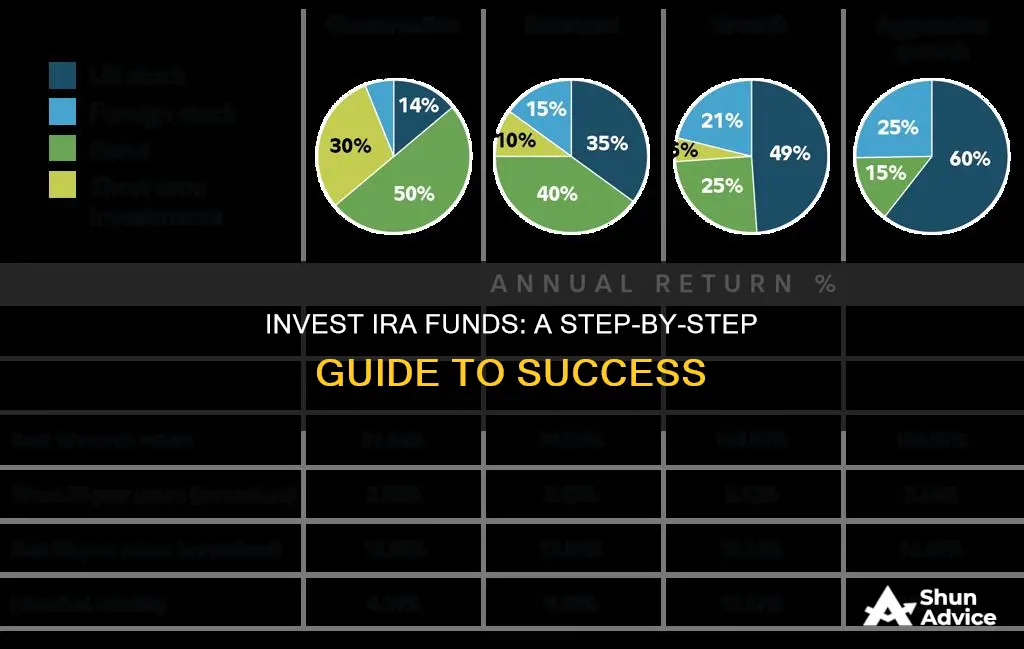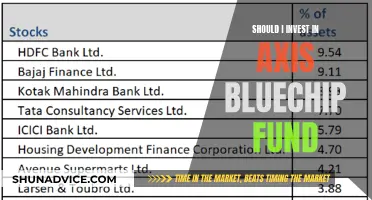
Investing in an IRA is a great way to save for retirement. IRAs are individual retirement plans that offer tax advantages. There are two main types: traditional IRAs and Roth IRAs. Both have different tax implications, with traditional IRAs offering upfront tax breaks and Roth IRAs offering tax-free withdrawals in retirement. IRAs provide a wider range of investment options compared to workplace plans, and you can choose to invest in individual stocks or a variety of mutual funds. When deciding how to invest your IRA funds, it's important to consider your risk tolerance, asset allocation, and time horizon. You can also seek professional advice or use robo-advisors for guidance. Understanding the different types of IRAs and their contribution limits, as well as the available investment options, will help you make informed decisions about how to invest your IRA funds effectively.
| Characteristics | Values |
|---|---|
| Investment options | Individual stocks, mutual funds, exchange-traded funds (ETFs), robo-advisors, target-date funds, bonds, and certificates of deposit |
| Tax advantages | No immediate tax break, but withdrawals are tax-free after retirement |
| Contribution limits | $6,500 in 2023 and $7,000 in 2024 for individuals under 50; $7,500 in 2023 and $8,000 in 2024 for individuals 50 and older |
| Age limit | None, as long as there is a source of earned income |
| Withdrawal penalties | Taxes and fees for early withdrawals |
| Investment selection | Based on risk tolerance, time horizon, and overall financial goals |
| Funding options | Cash, check, direct transfer from bank, or rollover from an existing retirement account |
What You'll Learn

Understand asset allocation
Understanding asset allocation is a key part of investing your IRA funds. Asset allocation refers to how your money is divided among different types of investments, including stocks, bonds, and cash. For example, if you invest $10,000 in an IRA account and $6,000 of it is in stock funds and $4,000 in bond funds, your asset allocation is 60/40.
It's important to consider your tolerance for risk when determining your asset allocation. Stocks, also known as equities, typically offer the biggest returns over time but also carry the most risk. On the other hand, bonds and other fixed-income investments are relatively safe and can help balance out the risk of stocks. As a general rule, younger investors can allocate more of their portfolio to stocks, while older investors may want to reduce their stock allocation to minimize risk as they approach retirement.
There are a few rules of thumb to help guide your asset allocation. One is to subtract your age from 100 (or 110 if you're willing to take on more risk). The resulting number is the percentage of your portfolio that should be allocated to stocks. For example, if you're 30 years old, you would allocate 70% to 80% of your portfolio to stocks. However, you may want to adjust this based on your personal risk tolerance.
Another popular strategy is the 60/40 portfolio, which consists of 60% stocks and 40% bonds. This approach aims to balance growth and income while reducing risk. Some financial experts, such as Warren Buffett, recommend maintaining a higher percentage of stocks, especially considering people are living longer and may need their retirement savings to last longer.
When allocating your assets, it's also important to consider the types of stocks and bonds you invest in. For stocks, you can choose between large-cap, mid-cap, and small-cap stocks, which refer to the size of the company. Small- and mid-cap stocks may exhibit higher volatility but potentially higher returns. For bonds, you can invest in a broad-based bond index fund that tracks a bond aggregate index, providing exposure to various types of debt securities.
Additionally, you can further diversify your portfolio by investing in global or international stock index funds, which provide exposure to non-U.S. stocks and emerging markets. This can help reduce your exposure to the U.S. economy specifically and benefit from the growth of other regions.
Vanguard Funds: Investing in the Future with FAANG
You may want to see also

Think about your tolerance for risk
When it comes to investing your IRA funds, it's important to consider your tolerance for risk. This involves evaluating your time horizon, or how long you plan to invest, as well as your ability to handle market volatility and potential losses. Here are some factors to consider when thinking about your risk tolerance:
- Time Horizon: How long do you plan to invest for? If you're investing for the long term, such as for retirement, you may be able to tolerate more risk as you have a longer timeframe to recover from any short-term losses.
- Risk Capacity: Consider your financial situation and how much risk you can afford to take. If you have a stable income, emergency savings, and discretionary funds, you may be in a better position to take on more risk.
- Risk Tolerance: Evaluate your emotional and psychological response to risk. How comfortable are you with market fluctuations and potential losses? If the idea of your investments losing value keeps you up at night, you may have a lower risk tolerance.
- Investment Knowledge and Experience: Your level of investment knowledge and experience can also impact your risk tolerance. If you are familiar with the markets and have invested before, you may feel more comfortable taking on risk.
- Investment Goals: What are your investment goals, and how much risk is required to achieve them? Aggressive growth goals may require taking on more risk, while preservation of capital may call for a more conservative approach.
- Rule of 100: A common rule of thumb is to subtract your age from 100 (or 110 for a more aggressive approach). The resulting number is the percentage of your portfolio that can be allocated to stocks, which are generally considered riskier than other asset classes. For example, if you're 30 years old, you could allocate 70-80% of your portfolio to stocks.
- Age-Based Allocation: Typically, younger investors can afford to take on more risk as they have a longer investment horizon. As you get closer to retirement, it's generally recommended to reduce your risk exposure and shift towards more conservative investments.
- Risk Tolerance Questionnaires: Many investment platforms offer risk tolerance questionnaires to help you determine your risk profile. These questionnaires consider factors such as your investment goals, time horizon, and emotional tolerance for risk.
Remember, it's important to regularly review and reevaluate your risk tolerance as your financial situation, investment goals, and market conditions change. Adjusting your investment strategy over time can help ensure that your portfolio remains aligned with your risk tolerance and investment objectives.
HDFC Mutual Fund: Offline Investment Guide
You may want to see also

Consider mutual funds
When considering how to invest your IRA funds, mutual funds are a popular option. Mutual funds are an easy way to diversify your investments and often perform better than average. They are also a good option for those who don't have the time or expertise to pick individual stocks.
There are two main types of mutual funds to consider: index funds and exchange-traded funds (ETFs). Index funds are passively managed funds that attempt to mimic the performance of an index, such as the S&P 500. ETFs are a type of fund that trades on an exchange and holds multiple assets, such as stocks, bonds, or commodities. Both types of funds offer a diversified investment option with minimal costs.
When choosing a mutual fund, it's important to consider your risk tolerance and investment goals. If you are approaching retirement, you may want to consider a more conservative investment mix, such as a target-date fund, which becomes more conservative as your retirement date approaches. On the other hand, if you are willing to take on more risk, you may want to consider a fund with a higher allocation to stocks or emerging markets.
It's also important to consider the fees associated with mutual funds, as these can eat into your returns over time. Look for funds with low expense ratios and no or low account minimums.
Additionally, you can choose between actively managed mutual funds and passively managed mutual funds. Actively managed funds have higher fees because they are actively trying to beat the market. Passively managed funds, on the other hand, aim to mimic the performance of an index and have lower fees.
Overall, mutual funds can be a great way to invest your IRA funds, offering diversification and the potential for strong returns. However, it's important to do your research and choose funds that align with your investment goals and risk tolerance.
Emergency Fund Strategies: Where to Invest for Peace of Mind
You may want to see also

Know when to leave it to the pros
If you don't want to select your own investments, you can outsource this task to a professional. There are two ways to get low-cost portfolio management: target-date funds and robo-advisors.
A target-date fund is a mutual fund designed to work towards the year its investors plan to retire; the funds are named accordingly – for example, if you plan to retire around 2050, you would select a target-date fund with 2050 in its title. This fund will then do all the work for you, rebalancing as needed and taking an appropriate amount of risk as you age. These funds tend to have higher expense ratios, but through an IRA, you can shop around for a wider selection to find a low-cost option. You put all of your IRA money into a single fund and don't need to diversify among target-date funds.
Robo-advisors, such as Betterment or Wealthfront, build and manage an ETF portfolio for you based on your age, risk tolerance and other factors. Most services will have you fill out an initial questionnaire. To use a robo-advisor, you would need to open an IRA account with one of these companies. The companies charge an annual management fee.
No matter what you choose, it's a good idea to take steps to minimise all types of investment fees. Left unchecked, these expenses can quickly start to eat into your portfolio's returns. Make sure your IRA offers competitive commissions and abundant low-cost investment options.
Hedge Fund GPs: Benefits of Investing in Their Own Fund
You may want to see also

Consider converting to a Roth IRA
Converting from a traditional IRA to a Roth IRA is a smart move if you expect to be in a higher tax bracket in retirement than you are now. With a traditional IRA, you don't pay taxes on your contributions but you will when you withdraw the money. On the other hand, with a Roth IRA, you've already paid taxes on the money you contribute, so you won't have to pay taxes when you withdraw it in retirement.
You can convert all or part of the money in a traditional IRA into a Roth IRA. Even if your income exceeds the limits for making contributions to a Roth IRA, you can still do a Roth conversion, sometimes called a "backdoor Roth IRA".
However, you will owe taxes on the money you convert. And, withdrawing converted funds within five years of the conversion will trigger a 10% penalty. Therefore, it may be more advantageous for individuals nearing retirement to simply pay taxes over time via traditional IRA withdrawals.
- Your income is unusually low this year, perhaps due to a career change.
- You want to leave your heirs tax-free income.
- You expect to be in a higher tax bracket after you retire, for example, if you live in a state with income taxes or if federal tax rates increase in the future.
When deciding whether to convert to a Roth IRA, consider issues like your tax rate now versus later, the tax bill you'll have to pay to convert, and your future plans for your estate. Remember, the conversion will be permanent and you can't revert the money back to a traditional IRA. It's best to talk to a tax advisor before making your decision.
A Swiss Guide to Index Funds Investing
You may want to see also
Frequently asked questions
You can open an IRA online in a few steps. You'll need to decide between an online broker or a robo-advisor, depending on whether you want to choose and manage your investments or take a more hands-off approach. Then, you'll need to choose a provider that fits your preference and open the account by providing some personal details.
If you're using a robo-advisor for your IRA, they will choose investments for you based on your goals and risk tolerance. If you're managing your investments yourself, consider building a portfolio out of low-cost index funds and ETFs, which can help ensure adequate diversification and minimize fees.
The IRS allows you to contribute up to $7,000 in 2024. People aged 50 or older can contribute an additional $1,000. These limits apply across all of your IRAs if you have multiple accounts.
You can fund your IRA with cash, a check, or a direct transfer from your bank. You can also take advantage of tax deductions or credits to increase your contributions. For example, you may be able to claim a deduction for your contribution to a traditional IRA, which can result in a bigger tax refund that you can use for next year's contribution.
Both types of IRAs offer tax advantages, but they work differently. With a traditional IRA, you don't pay taxes on your contributions until you withdraw the money. With a Roth IRA, you've already paid taxes on your contributions, so you won't pay taxes when you withdraw the money in retirement.







